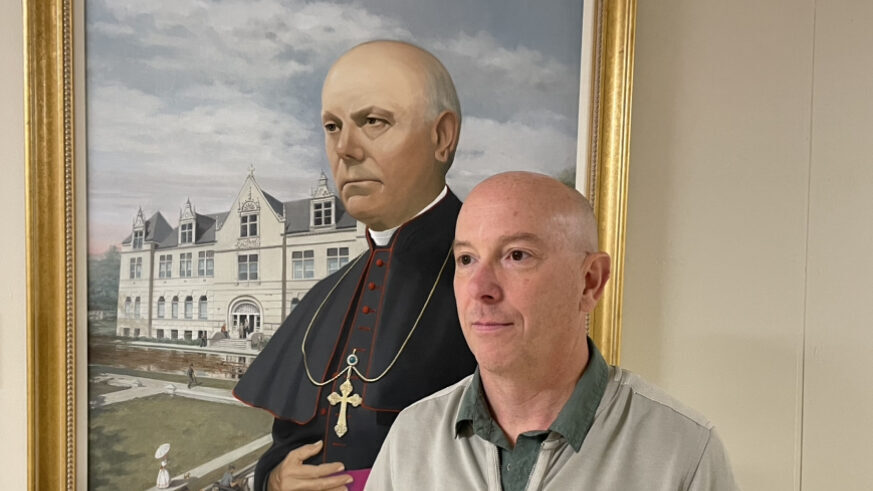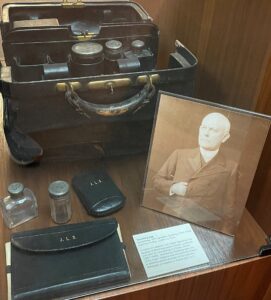“In search of Lank” — a pilgrim’s progress

John D. Spalding, third cousin of Bishop John L. Spalding, compares profiles and Napoleonic hand-in-coat gestures with a portrait of his relative at Spalding Pastoral Center in Peoria. (Photo provided by Sr. Lea Stefancova, FSJB)
“You look like the Bishop.”
He hears that a lot. John D. (David) Spalding, of Middletown, Connecticut, is on the trail for information about John L. (Lancaster) Spalding, the first Bishop of Peoria, his third cousin, three generations removed. But there are times he doesn’t feel very far removed from his distinguished relative at all.
One of those times occurred when his trail led him to Peoria, and Beth Slevin Krider, a distant cousin, took him to meet John Slevin (now deceased) and his wife Mary. John Slevin’s grandmother was Mary Ellen Spalding, a sister of Bishop Spalding. After gazing intently into the visitor’s eyes for a few seconds, Slevin said, “You look like the Bishop. You’ve got his head.”
After gazing intently into the visitor’s eyes for a few seconds, Slevin said, “You look like the Bishop. You’ve got his head.”
“The Bishop is here”
It was a similar story when John was spotted by Sr. Lea Stephancova, FSJB, vice postulator of Venerable Fulton Sheen’s cause for sainthood, and a curator for the Fulton J. Sheen Museum in the Spalding Pastoral Center in Peoria. As John entered the museum, Sr. Lea saw him across the room, gasped, threw her hands in the air, and announced “The Bishop is here!”

Last year, John D. Spalding visited the motherhouse of the Sisters of the Third Order of St. Francis in East Peoria. The Sisters honor John’s forebear, Bishop John L. Spalding, as their founder. (Photo provided by Allison Carr, archivist, OSF HealthCare)
Although he was now becoming somewhat acclimatized to a similar reaction — at least when visiting the Diocese of Peoria — for much of his life John probably would have responded, “Who, me?”
The child of a Catholic father and Protestant mother, who later divorced, John was baptized Catholic but raised Protestant. His birth on June 3, 1965 followed that of Bishop Spalding by 125 years and a day (June 2, 1840). Unknowingly, he would follow Bishop Spalding’s path in other ways as well.
“Growing up, religion and spiritual thinking was almost an obsession of mine,” he said. He offers a quote from Bishop Spalding’s writings indicating a similar focus: “Ceaseless growth toward God — this is the ideal, this is the law of human life, proposed and sanctioned alike by Religion, Philosophy, and Poetry.” (John L. Spalding, Education and the Higher Life, p. 138)
The current century’s John Spalding, a self-described “Christian who works at a Buddhist meditation retreat center,” has a broad education including a Bachelor of Philosophy, magna cum laude, from Eastern Nazarene College in Massachusetts, and a Master of Theological Studies from Harvard Divinity School.
As a freelance journalist for many years, he wrote on religion and spirituality. Doing Google searches under his own name to find where his articles were appearing, the “other” John Spalding’s name kept popping up.
He remembers his initial reaction as irritation. “I’m trying to establish my identity in the world. And here’s John Spalding, who’s not me, and I’m not a 19th century Bishop.” He wasn’t totally unaware of the Spalding family connection, but wasn’t particularly interested in pursuing it, either.
He wasn’t totally unaware of the Spalding family connection, but wasn’t particularly interested in pursuing it, either.
“What am I doing with my life?”
However, after his parents passed away, his interest in genealogy grew and gradually morphed into something with a strong spiritual element. He recalls reflecting, “What am I doing with my life?”
And so it began. “Once I really discovered John Lancaster, he resonated with me on a very deep level,” he acknowledges. He was also impressed by John L’s accomplishments, not only as the first Bishop of Peoria, but as a co-founder of the Catholic University of America, and as a collaborator on the landmark Baltimore Catechism.

The current John D. Spalding’s genealogical and spiritual odyssey has taken him on a “long and winding road,” including Peoria; the University of Notre Dame at South Bend; St. Mary’s County, Maryland; and Lebanon, Kentucky, Bishop John L. Spalding’s birthplace. John found the Bishop’s traveling bag on display at the Archdiocesan History Center in Louisville. (Photo provided by John D. Spalding)
In his spare time, Bishop Spalding even helped President Theodore Roosevelt and banker J. P. Morgan arbitrate an end to the Great Coal Strike of 1902.
In fact, it would be hard to argue that with the exception of Venerable Fulton Sheen, the Diocese of Peoria boasts no one who has made a greater impact in the world beyond the diocese than John Lancaster Spalding.
Coincidentally (or not) young Sheen was serving Mass for Bishop Spalding one day, when he dropped a wine cruet on the altar, causing it to shatter. Spalding consoled him by saying, “Someday you will be just as I am.” So as to say, a bishop.
Above all, John D. was impressed by the inner man. “He was a profoundly spiritual person. He had a real emotional depth and emotional heart and a deep, deep spiritual life.” Over the last two years, John has been tracing the arc of the bishop’s life and spirituality while on a genealogical-spiritual pilgrimage of his own.
All roads lead to home — and Rome?
He learned how, at age 12, in September, 1852, John L. Spalding embarked on a lifelong quest to discover God’s will in his life by leaving his home in Lebanon, Kentucky to attend St. Mary’s College on the edge of town. John Lancaster Spalding was nicknamed “Lank” in his early days, and John David Spalding has come to think of his own odyssey to find out more about his relative — and himself — as the “Search for Lank.”
John David Spalding has come to think of his own odyssey to find out more about his relative — and himself — as the ‘Search for Lank.’
John D. has long been a pilgrim. In 1998, he walked the 500-mile Camino de Santiago from St.-Jean-Pied-de-Port in southwestern France, to Santiago in the northwest corner of Spain.
Don’t be surprised to read about the future results of his search in a book in the not-too-distant future. Other than that, John’s not quite ready to speculate on where his desire to explore “synchronicity” of soul with his third cousin three times removed might lead. Sr. Lea smiles with her own idea of where he might be headed. “Home,” she says.
John Lancaster Spalding Scholarship Fund Grants
In the great “Lank” tradition of higher learning, the John Lancaster Spalding Scholarship Fund grants tuition assistance scholarships from the endowment fund established as a result of the Diocese of Peoria ROOTED IN FAITH Campaign. These are available for the 2024-2025 school year for students enrolled in or intending to enroll in grades kindergarten through 12 in any Catholic school located in the Diocese of Peoria whose families are active members of a Catholic parish in the diocese.
All grants will be based on financial need objectively assessed. Information about the grants and application materials may be obtained from the Diocesan website at www.cdop.org under the heading “Catholic Education” and then under “Financial Assistance.”
Consult the detailed protocols and procedures and checklist for all requirements necessary to be eligible for an award. Parents must apply at: https:// online.factsmgt.com/aid. Families of students currently receiving grants are reminded that all grants are for one year only, and anyone seeking to renew a grant for the 2024-2025 school year must reapply. The deadline date for the completed application is April 26, 2024. Notification of grant awards will be made in June of 2024.





